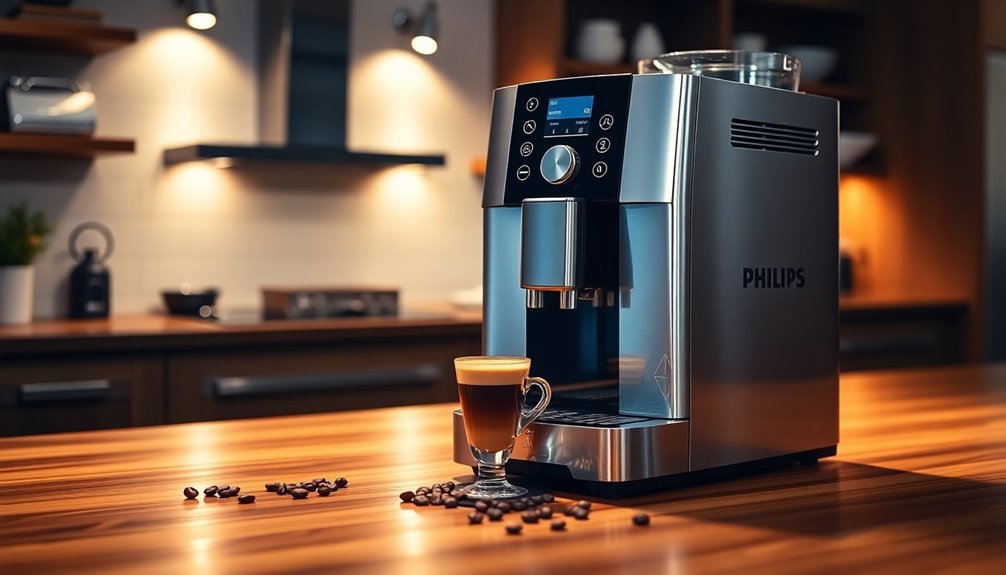Choosing the best espresso tamper can elevate your brewing game. Consider materials like stainless steel for durability or wooden for comfort. Opt for flat bases for consistent tamping and even extraction. You can select from various types, from manual to calibrated for precise pressure. Remember, consistent tamping is essential for rich, balanced espresso. Keep your tamper clean and store it properly to extend its life. Avoid common mistakes like over-tamping or uneven pressure. With the right tools and techniques, you're on your way to barista-quality espresso. Explore further insights and tips to enhance your home brewing experience!
Key Takeaways
- Material Matters: Opt for stainless steel or quality wood for durability and consistent tamping results; avoid plastic for better performance.
- Choose the Right Type: Manual tampers are great for beginners, while calibrated and palm tampers offer precision for experienced baristas.
- Consider Base Shape: Flat bases ensure even pressure and prevent channeling, while convex bases may complicate pressure application.
- Focus on Consistency: Practice consistent tamping techniques to achieve uniform extraction and enhance the flavor of your espresso.
- Maintenance is Key: Regularly inspect and clean your tamper to prolong its lifespan and maintain optimal brewing quality.
Understanding Tamper Materials
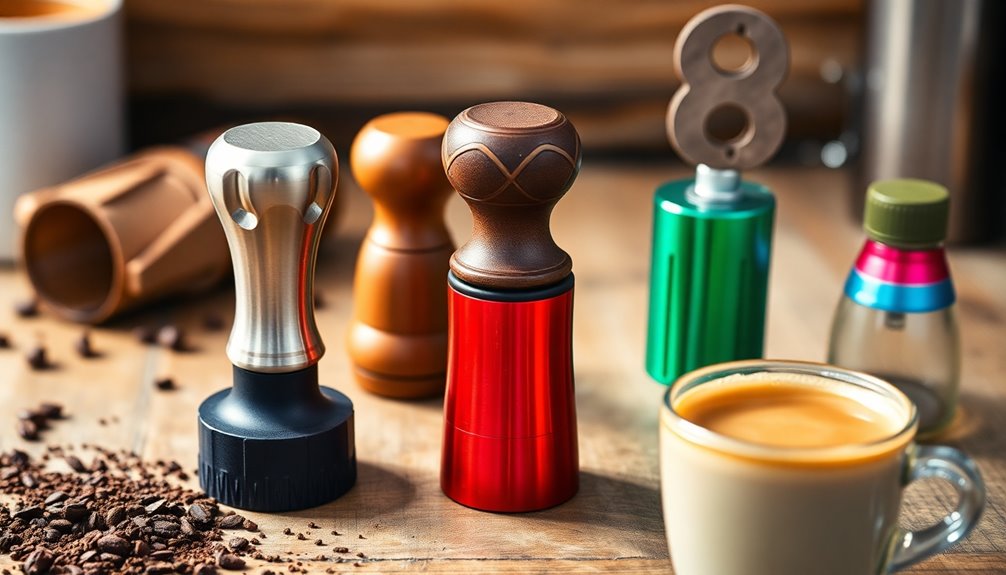
When it comes to choosing the right espresso tamper, understanding the materials is key to enhancing your brewing experience.
Stainless steel tampers are durable, heat-resistant, and provide the weight needed for effective tamping, making them a favorite among professionals. Consistency in tamping is crucial for achieving reliable espresso shots, and stainless steel tampers excel in this area.
If you're just starting, an aluminum tamper might be more suitable; it's lightweight and cost-effective, although it may not last as long.
Wooden tampers offer a comfortable grip and aesthetic appeal, but they usually have a metal base to guarantee proper pressure distribution.
Finally, while plastic tampers are affordable and lightweight, they lack durability and are often not favored by enthusiasts.
Choosing the right material will greatly impact your brewing quality and enjoyment.
Exploring Tamper Base Shapes

Understanding the different shapes of tamper bases can greatly impact your espresso brewing experience.
Flat tamper bases are your go-to for consistency, as they create straight, even pucks and allow for uniform pressure application. This helps prevent channeling and can lead to better extraction. Additionally, all tamper bases are made with food-grade stainless steel for durability and safety, ensuring a long-lasting tool for your coffee preparation.
On the other hand, convex tamper bases can seal tightly against the basket, minimizing side-channeling, but they may make it harder to apply even pressure.
For specialized needs, options like C Flat or Euro Flat tampers tackle specific issues like channeling and mounding.
Ultimately, the right shape for you depends on your technique and the equipment you use, so choose wisely to enhance your brewing process.
Different Types of Tampers
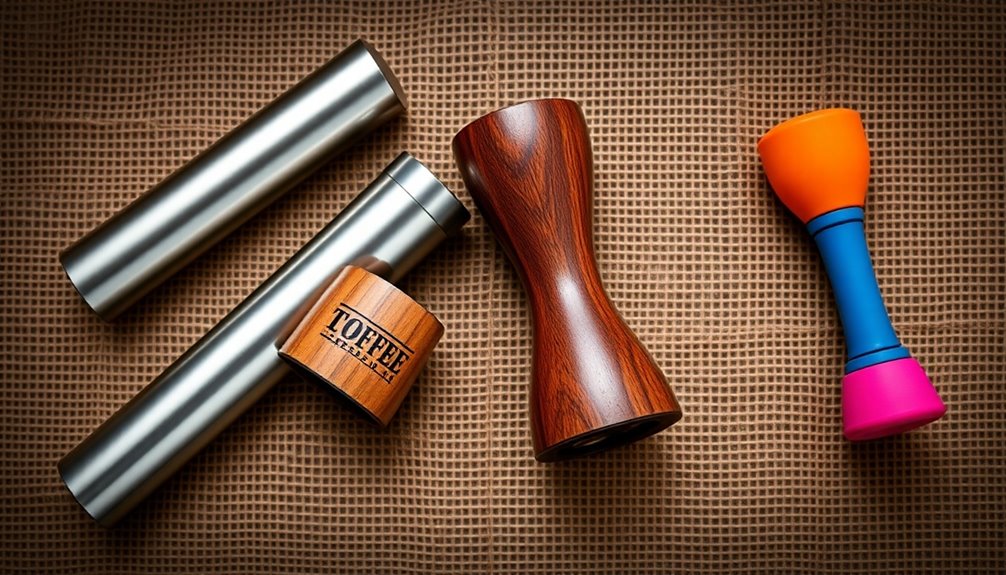
While choosing the right tamper can seem intimidating, it's essential to know the different types available to find one that suits your brewing style. Manual espresso tampers are simple and affordable, perfect for beginners, but they require practice to apply the right pressure. Proper tamping eliminates air pockets, ensuring optimal extraction and flavor in your espresso. Calibrated tampers offer precision with an internal spring, ensuring consistent results but come with limitations due to maintenance. For more experienced baristas, palm and lever tampers provide greater control and comfort. Automatic tampers, while convenient, can be pricey. Specialty options, like dual-head and magnetic tampers, cater to unique preferences and can be extravagant in design. Choose the type that aligns with your skill level and espresso-making goals for the best results.
Key Features for Effective Tamping

To achieve the perfect espresso shot, mastering key features for effective tamping is essential.
Start with proper ground leveling—add your coffee to the portafilter, then run your index finger across the top to remove excess grounds, ensuring an even surface.
Next, focus on your form: turn your tamping-side hip toward the counter, keep your wrist straight, and use your body weight when applying pressure to prevent strain. Aim for an initial pressure of about 15 pounds, then increase to 20-30 pounds for compacting. Proper tamping creates resistance for optimal water flow and contributes to the overall espresso quality.
Finally, polish and inspect your puck using a gentle twisting motion, ensuring there are no gaps. Clean the portafilter afterward to maintain your equipment and enhance the quality of your brews.
Advantages of Using a Tamper
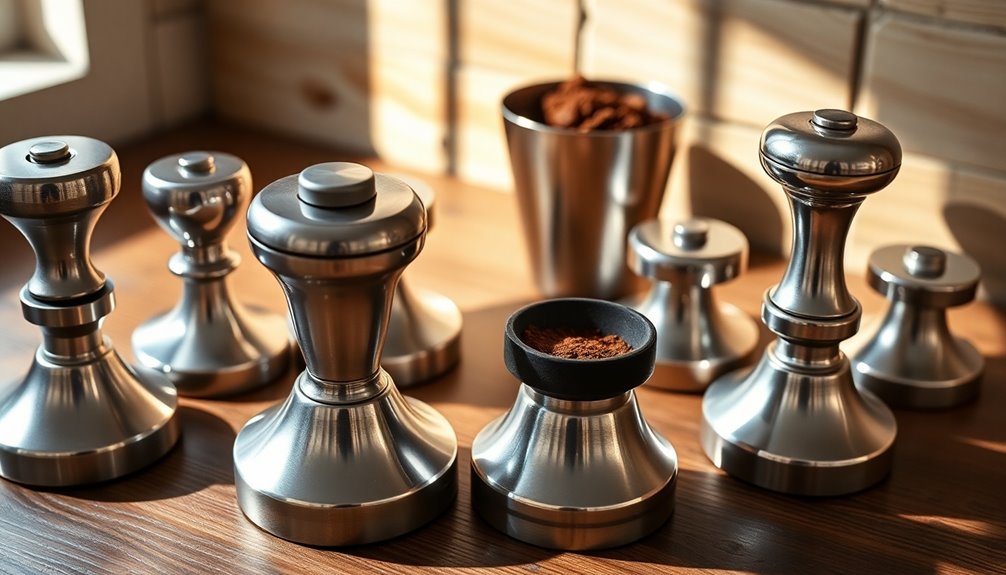
Using a tamper can greatly elevate your espresso-making game, as it brings a level of consistency and precision that's hard to achieve manually.
With a tamper, you guarantee uniform extraction across multiple shots, eliminating one variable in your quest for the perfect espresso. This leads to predictability in flavor profiles and quality, making each cup a delightful experience.
Moreover, you gain precise control over tamping pressure, depth, and distribution, optimizing the extraction process for various coffee beans. An automatic tamper can provide consistent tamping pressure, ensuring uniformity in flavor profiles and enhancing the overall quality of your espresso.
A good tamper prevents channeling by guaranteeing even tamping, while also speeding up your brewing routine. This efficiency reduces strain on your wrists, enhances productivity, and minimizes coffee wastage, making it an essential tool for every home barista.
Top Recommendations for Home Baristas
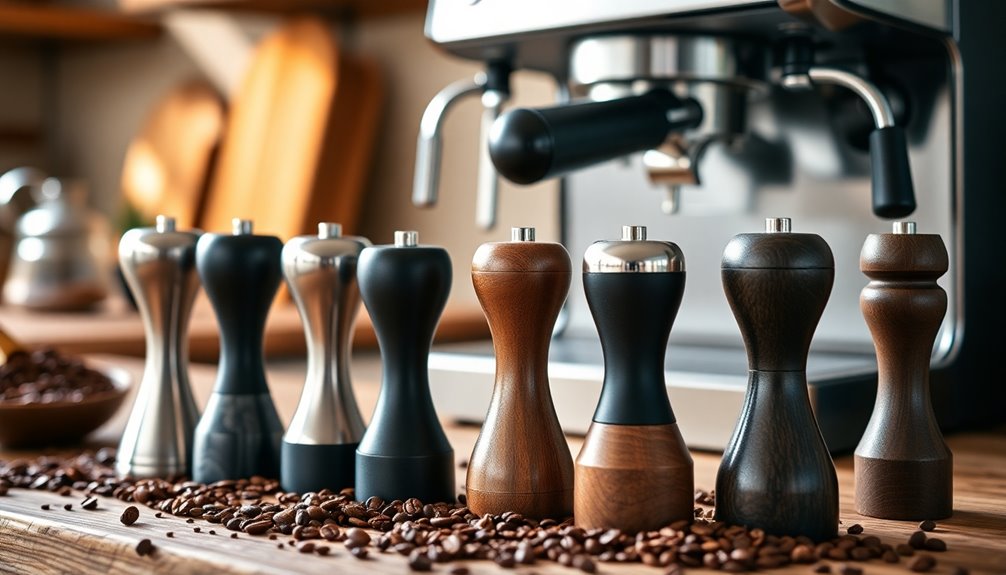
Investing in a quality tamper can greatly enhance your espresso experience, but choosing the right one can be overwhelming with so many options available.
For top recommendations, consider the Normcore Calibrated Tamper V4 for its precision and durability, available in seven sizes.
The MHW-3Bomber is a favorite among professionals and world champions, ensuring consistent pressure. A properly tamped puck presents a uniform surface to water, ensuring optimal extraction and flavor.
If you're after a foolproof option, try the Decent Tamper, known for its perfect weight and spring-loaded calibration.
For a budget-friendly choice, the LuxHaus Tamper offers excellent performance at a fraction of the cost.
Each of these tampers will elevate your home barista skills and help you achieve the perfect shot every time.
How to Choose the Right Tamper
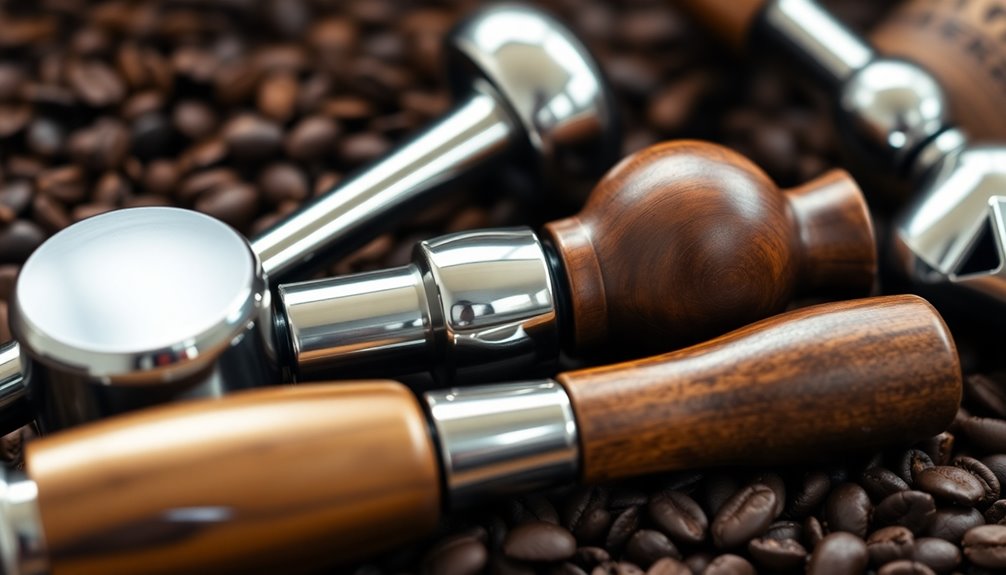
How do you guarantee that your espresso tamper meets your unique brewing needs?
First, make certain the tamper's base diameter matches your portafilter basket, as common sizes range from 51mm to 58mm. A snug fit is vital for ideal extraction and to avoid channeling.
Next, consider the material: stainless steel offers durability and weight, while aluminum is lighter and more affordable. A heavier tamper can help ensure consistent pressure which is essential for optimal extraction.
Ergonomics matter too; heavier tampers allow for consistent pressure with less effort, and ergonomic handles enhance grip.
Finally, think about the base design. Flat tampers are versatile, while convex designs can prevent side-channeling but require technique.
Maintenance Tips for Espresso Tampers

Choosing the right tamper is just the beginning; maintaining it's key to guaranteeing consistent espresso quality.
Start by brushing off coffee grounds with a soft towel or brush after each use. If stubborn grounds stick, use a cleaning station or an ear syringe to blow them away. Rinse under running water if needed, and a camera lens brush can help with tiny particles. Additionally, ensure to check for any visible wear on your tamper to ensure it functions properly.
For deep cleaning, soak your tamper in vinegar or Coca Cola for 10-30 minutes.
Store it in a dry, cool place to avoid humidity damage, and inspect it regularly for wear. Avoid harsh chemicals and make certain it's completely dry after cleaning to prevent rust.
Following these tips will keep your tamper in top shape!
Common Tamping Mistakes to Avoid

While tamping might seem straightforward, several common mistakes can undermine your espresso quality.
First, inconsistent pressure leads to shots that are either under-extracted or over-extracted, affecting flavor. Aim for 30 pounds of pressure to maintain consistency, as consistent tamping is crucial for achieving uniform espresso shots.
Next, make certain your tamping is level; tamping at an angle causes uneven packing, which disrupts water flow.
Over-tamping compresses the coffee too tightly, resulting in bitterness, while under-tamping creates a loose puck, leading to weak shots.
Finally, avoid tapping the portafilter after tamping, as this can crack the coffee puck and cause channeling. Instead, lock it into the machine gently.
Enhancing Your Home Brewing Experience

To elevate your home brewing experience, it's essential to invest in the right tools and techniques that enhance both the flavor and consistency of your espresso.
Start by selecting a tamper made from durable materials like stainless steel or wood, which offer comfort and longevity. Choose a tamper type that suits your style; flat tampers are great for beginners, while convex options can help prevent channeling. Proper tamping is crucial for achieving uniform extraction and improving flavor consistency.
Look for ergonomics too—comfortable grips and adjustable depth features can make a significant difference.
Finally, focus on performance: a tamper with a calibrated base guarantees consistent pressure, leading to even extraction.
Frequently Asked Questions
Can I Use a Regular Kitchen Tool Instead of a Tamper?
Yes, you can use a regular kitchen tool instead of a tamper. Items like a tablespoon, shot glass, or even the back of a spoon can work well for tamping coffee.
Just remember to apply even pressure and use a circular motion to guarantee consistent distribution.
While these alternatives may not deliver the same precision as a dedicated tamper, they can be effective in a pinch.
Practice will help you achieve better results!
How Do I Clean and Maintain My Espresso Tamper?
To clean and maintain your espresso tamper, start by brushing off coffee grounds with a soft towel after each use.
Rinse it under warm water, and for stubborn residue, soak it in vinegar or a soap solution.
Utilize a camera lens brush for small particles, and guarantee it's completely dry before storage.
Regularly check for buildup, and choose materials like stainless steel for durability and easier cleaning.
What Is the Ideal Weight for a Tamper?
The ideal weight for a tamper usually falls around 0.5 lb or more, as heavier tampers help you achieve consistent compaction with less effort.
You should feel comfortable holding it to avoid fatigue during use. Aim for a tamper that allows you to apply 15 to 25 pounds of pressure without strain.
Ultimately, finding the right balance between weight and comfort is key to perfecting your espresso tamping technique.
How Often Should I Replace My Espresso Tamper?
You should replace your espresso tamper when you notice signs of wear, like misalignment or uneven tamping.
If the tamper no longer provides consistent pressure or shows visible damage, it's time for a new one.
Regularly check for rust or corrosion, as these indicate it might need replacing.
If you find it difficult to achieve an even coffee bed, consider getting a new tamper to guarantee ideal extraction and flavor.
Does the Color of the Tamper Affect Coffee Flavor?
No, the color of your tamper doesn't affect the flavor of your coffee.
What really matters is how you use it. Proper tamping technique, consistent pressure, and the right fit with your portafilter are key to achieving a balanced extraction.
Focus on those factors instead. The material and design of the tamper play a role in performance, but the color is just a cosmetic detail that won't change your brew's taste.
Conclusion
To sum up, choosing the right espresso tamper can elevate your home brewing experience greatly. By understanding tamper materials, base shapes, and key features, you’ll make an informed decision. Don’t forget to maintain your tamper and avoid common mistakes for the best results. With the right tools and techniques, you’ll enjoy rich, flavorful espresso that rivals your favorite café. So, get ready to impress yourself and others with your barista skills! When choosing the best espresso tampers, consider investing in a high-quality, durable option that fits comfortably in your hand. Look for tampers with adjustable pressure settings to customize your brewing process. By selecting one of the best espresso tampers, you’ll ensure a consistent and professional-quality espresso every time.




